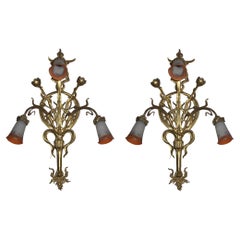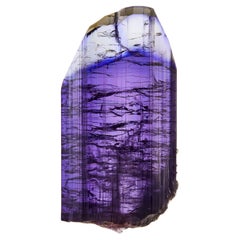Vintage Wave Motif Sconces
Antique Early 1900s French Art Nouveau Wall Lights and Sconces
Bronze
People Also Browsed
Antique Late 18th Century German Chinoiserie Ceramics
Porcelain
Antique 15th Century and Earlier Tanzanian Natural Specimens
Other
Antique 19th Century French Napoleon III Planters, Cachepots and Jardini...
Bronze, Enamel, Ormolu
21st Century and Contemporary English Chinoiserie Pier Mirrors and Conso...
Paint, Wood, Gesso
Antique 1860s German Rococo Figurative Sculptures
Porcelain
Antique Mid-19th Century British Victorian Tea Sets
Silver
Antique Late 19th Century French Islamic Garniture
Onyx, Bronze
Antique 19th Century English Gothic Revival Lanterns
Bronze
Antique 19th Century French Cabinets
Bronze
Antique 1810s German Empire Planters, Cachepots and Jardinières
Bronze
Antique 16th Century English Elizabethan Pitchers
Silver
18th Century Portrait Paintings
Canvas, Oil
Antique Late 19th Century Japanese Meiji Sculptures and Carvings
Bronze
20th Century Chinese Qing Armchairs
Rosewood
Antique 15th Century and Earlier Tang Antiquities
18th Century Still-life Paintings
Oil
Louis Majorelle for sale on 1stDibs
Louis-Jean-Sylvestre Majorelle, more commonly known as Louis Majorelle, was a French artist, metalworker and Art Nouveau designer celebrated for his bedroom furniture, cabinets, chairs and decorative objects.
In 1877, Majorelle moved to Paris from the town of Nancy where he began his studies in painting under Jean-François Millet at the École de Beaux Arts. Following the death of his father, a furniture designer, he returned to Nancy and took over the family workshop. Parisian architect Henri Sauvage designed Majorelle’s house in Nancy, Villa Majorelle, which featured stained glass by Jacques Gruber.
In order to increase productivity and reduce costs — as well as shift the family business’s focus from reproductions of 18th-century furniture such as Louis XV chairs to instead working in the era’s Art Nouveau style — Majorelle integrated modern techniques and processes at his atelier (these changes were in part inspired by innovative glassmaker Emile Gallé).
The workshop became known for Majorelle’s distinctive designs and the pronounced craftsmanship of its offerings. There were tables made from mahogany and ormolu that featured handsome bronze mounts and marquetry, table lamps that shared common ground with the prized designs associated with Tiffany Studios, and decorative pieces that Majorelle produced in partnership with Daum, a revered manufacturer of French art glass.
The work was very much characterized by the botanical motifs and curvaceous silhouettes of Art Nouveau design, and the business was successful. Majorelle produced a range of items during the early 1900s and was a participant in the 1900 Paris Exposition as well as the Exposition de l'Ecole de Nancy in 1903.
In 1916, a devastating fire broke out in Majorelle’s factory on the rue du Vieil-Aître in Nancy. It destroyed all of the company’s awards, sketches, molds, equipment and archives of Majorelle’s work. In 1917, destruction again shook his business when his shop on the rue Saint-Georges was bombed by German aircraft. The designer marched on — he relocated to Paris where he shared a workspace and created vases and other vessels in the Art Deco style before he moved back to Nancy. Majorelle designed the Nancy Pavilion at the International Exhibition of Modern Decorative and Industrial Arts in 1925 with Alfred Lévy. He died in 1926.
Find antique Louis Majorelle cabinets, seating and decorative objects on 1stDibs.
A Close Look at art-nouveau Furniture
In its sinuous lines and flamboyant curves inspired by the natural world, antique Art Nouveau furniture reflects a desire for freedom from the stuffy social and artistic strictures of the Victorian era. The Art Nouveau movement developed in the decorative arts in France and Britain in the early 1880s and quickly became a dominant aesthetic style in Western Europe and the United States.
ORIGINS OF ART NOUVEAU FURNITURE DESIGN
- Emerged during the late 19th century
- Popularity of this modernizing style declined in the early 20th century
- Originated in France and Britain but variants materialized elsewhere
- Informed by Rococo, Pre-Raphaelite art, Japanese art (and Japonisme), Arts and Crafts; influenced modernism, Bauhaus
CHARACTERISTICS OF ART NOUVEAU FURNITURE DESIGN
- Sinuous, organic and flowing lines
- Forms that mimic flowers and plant life
- Decorative inlays and ornate carvings of natural-world motifs such as insects and animals
- Use of hardwoods such as oak, mahogany and rosewood
ART NOUVEAU FURNITURE DESIGNERS TO KNOW
ANTIQUE ART NOUVEAU FURNITURE ON 1STDIBS
Art Nouveau — which spanned furniture, architecture, jewelry and graphic design — can be easily identified by its lush, flowing forms suggested by flowers and plants, as well as the lissome tendrils of sea life. Although Art Deco and Art Nouveau were both in the forefront of turn-of-the-20th-century design, they are very different styles — Art Deco is marked by bold, geometric shapes while Art Nouveau incorporates dreamlike, floral motifs. The latter’s signature motif is the "whiplash" curve — a deep, narrow, dynamic parabola that appears as an element in everything from chair arms to cabinetry and mirror frames.
The visual vocabulary of Art Nouveau was particularly influenced by the soft colors and abstract images of nature seen in Japanese art prints, which arrived in large numbers in the West after open trade was forced upon Japan in the 1860s. Impressionist artists were moved by the artistic tradition of Japanese woodblock printmaking, and Japonisme — a term used to describe the appetite for Japanese art and culture in Europe at the time — greatly informed Art Nouveau.
The Art Nouveau style quickly reached a wide audience in Europe via advertising posters, book covers, illustrations and other work by such artists as Aubrey Beardsley, Henri de Toulouse-Lautrec and Alphonse Mucha. While all Art Nouveau designs share common formal elements, different countries and regions produced their own variants.
In Scotland, the architect Charles Rennie Mackintosh developed a singular, restrained look based on scale rather than ornament; a style best known from his narrow chairs with exceedingly tall backs, designed for Glasgow tea rooms. Meanwhile in France, Hector Guimard — whose iconic 1896 entry arches for the Paris Metro are still in use — and Louis Majorelle produced chairs, desks, bed frames and cabinets with sweeping lines and rich veneers.
The Art Nouveau movement was known as Jugendstil ("Youth Style") in Germany, and in Austria the designers of the Vienna Secession group — notably Koloman Moser, Josef Hoffmann and Joseph Maria Olbrich — produced a relatively austere iteration of the Art Nouveau style, which mixed curving and geometric elements.
Art Nouveau revitalized all of the applied arts. Ceramists such as Ernest Chaplet and Edmond Lachenal created new forms covered in novel and rediscovered glazes that produced thick, foam-like finishes. Bold vases, bowls and lighting designs in acid-etched and marquetry cameo glass by Émile Gallé and the Daum Freres appeared in France, while in New York the glass workshop-cum-laboratory of Louis Comfort Tiffany — the core of what eventually became a multimedia decorative-arts manufactory called Tiffany Studios — brought out buoyant pieces in opalescent favrile glass.
Jewelry design was revolutionized, as settings, for the first time, were emphasized as much as, or more than, gemstones. A favorite Art Nouveau jewelry motif was insects (think of Tiffany, in his famed Dragonflies glass lampshade).
Like a mayfly, Art Nouveau was short-lived. The sensuous, languorous style fell out of favor early in the 20th century, deemed perhaps too light and insubstantial for European tastes in the aftermath of World War I. But as the designs on 1stDibs demonstrate, Art Nouveau retains its power to fascinate and seduce.
There are ways to tastefully integrate a touch of Art Nouveau into even the most modern interior — browse an extraordinary collection of original antique Art Nouveau furniture on 1stDibs, which includes decorative objects, seating, tables, garden elements and more.
Finding the Right sconces-wall-lights for You
From the kitchen to the bedroom and everywhere in between, there is one major part of home decor that you definitely want to master: lighting. It’s no longer merely practical — carefully selected wall lights and sconces can do wonders in establishing mood and highlighting your distinctive personality.
We’re a long way from the candelabra-inspired chandeliers of the medieval era. Lighting designers have been creating and reinventing lighting solutions for eons. Because of the advancements crafted by these venturesome makers, we now have the opportunity to bring unique, customizable lighting solutions into our homes. It’s never been easier to create dramatic bedrooms, cozy kitchen areas and cheerful bars than it is today. Think of an elegant wall sconce as functional as well as a work of art, adding both light and style to your hallways, whimsical kids’ rooms and elsewhere.
When choosing a lighting solution, first determine what your needs are: Will you opt for a moody or a bright feel? The room that will serve as your home office will need adequate lighting — think “the brighter, the better” for this particular setting. For the bedroom, bedside wall lamps with warm-temperature bulbs could be the way to go to induce a sense of calm or intimacy. Try to match the style of the wall light or sconce that you’re installing to the overall design scheme of your room. It’s never “just a light.” You should approach the lighting of a room with a mindset that is one part practical and one part aesthetics-driven.
Let 1stDibs help you set the mood with the right wall lights and sconces for your home. Our collection includes every kind of fixture, from sculptural works by Austrian craftsman J.T. Kalmar to chic industrial-style wall sconces, from adjustable painted aluminum wall lamps designed by Artemide to a wide variety of minimalist mid-century modern masterpieces.


